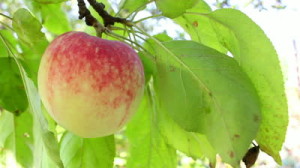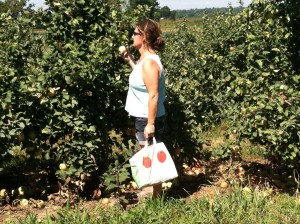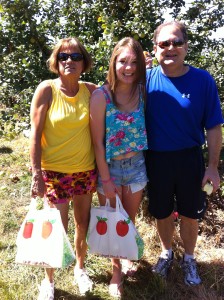Rosh Hashanah Sweetens The Deal
The Jewish New Year is off to a sweet start as I pluck another huge yellowish-pink Honeycrisp apple that hangs heavy on a leafy tree branch. I open my mouth wide and bite into the succulent, crunchy fruit and let the juice drip down my chin and make my face sticky. On Rosh Hashanah, apple picking is a great tradition for several reasons. It brings my family together; it symbolizes sweetness for the year ahead; and it’s an opportunity to share the gleanings, or extra crops, with those who are hungry and less fortunate at a local food pantry. Plus, I have an excuse to make a lot of yummy recipes, including apple raisin koogle, applesauce, apple crisp, apple salad, and whatever new treat I can find like honey mustard chicken with apples. (It must have something to do with fasting on Yom Kippur in 10 days).
At this time of year, we greet each with La Shana Tovah. May you be inscribed in the Book of Life for a good year.” This means God judges us and writes down our fate for the next year. During the High Holidays, which is also called teshuvah, Hebrew for “returning to God, or Ten Days of Repentance, we are told to repent for our sins and ask forgiveness for mistakes that we’ve made in the past year. If we are honest with ourselves and walk the walk (not just talk about it), God shows mercy on us. In other words, it’s time to do a little soul searching, fess up to our wrongdoings, and actually confront those we have hurt and ask for their forgiveness (and forgive ourselves). By doing so,  we can clean the slate, start fresh, and God will bless us in the year ahead. It’s not always an easy task, but it’s an important Jewish value and a good lesson to teach our children.
For young children, a fun, tangible way to do this is through the ceremony of tashlikh, Hebrew for “you shall cast away.â€Â In this ritual, we gather by a body of natural water, like a lake, sea, river, stream, or pond, and we empty our pockets of bread crumbs.  The water is symbolic, of course. We toss the bread or crackers into the water to symbolize the casting off of sins. Again, a great opportunity to be outside, enjoy a sunshiny fall day, spend time with family, and ponder these questions:
Looking back:
- During the past year, what has made you really happy? What are you most proud of?
- What do you really regret not doing last year? What are you sorry for?
- What opportunities did you miss?
- Whom do you wish you had not hurt?
- How might you make up for what you did?
Looking ahead:
- What new goals have you set for yourself for the coming year?
- How would you like to do things differently in the coming year?
- How will you enhance your life Jewishly during the coming year?
- Today is the birthday of the world! What two wishes do you have for the world?
Tashlikh, by the way, is typically done on the first day of Rosh Hashanah (unless it’s Shabbat, then it’s the second day of Rosh Hashanah), but can be performed up until Hoshana Rabba (the last day of Sukkot).
So, as we listen to the sound of the Shofar, dip apples in honey, and nibble on the countless pomegranate seeds that symbolize the infinite good deeds each of is us able to do for others, we say Shehecheyanu, the Jewish prayer to celebrate special occasions.
Barukh atah Adonai, Eloheinu, melekh ha’olam
Blessed are you, Lord, our God, sovereign of the universe.
Shehecheyanu v’kiyimanu v’higi’anu laz’man hazeh. (Amein)
Who has kept us alive, sustained us, and enabled us to reach this season (Amen)
Finally, we bid farewell to 5773 and set goals for 5774 to make the world a better place by doing  tikkun olam, or good deeds. Hint: start with one area in our life that we can improve, and pick a community service project to do together as a family.
And if we don’t succeed, there’s always next year.




